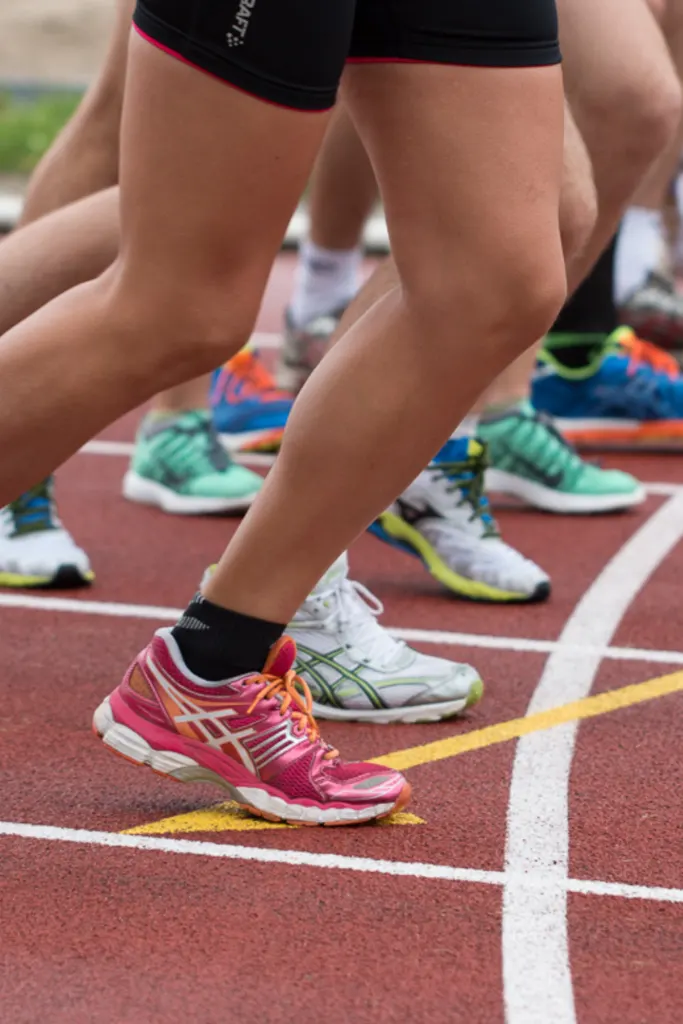If you’ve ever wondered how fast you can run a certain distance to help you in your training, then you’re not alone.
Runners rely on all sorts of data to help them train smarter.
Your expected race paces and race times in particular are essential to understand in order to get he most out of your training and perform at your best on race day.
This is where Jeff Galloway’s magic mile running test comes in.
But what exactly is the magic mile running test and how does it benefit you and your training? More importantly, how do you use it to get the most out of it?
In this guide we’ll explore:
- Who is Jeff Galloway?
- What is the magic mile?
- How is the magic mile calculated?
- What are the benefits of using the magic mile?
- Where to run the magic mile
- How to perform the magic mile
- Magic mile Q&A
- 5 tips on using the magic mile
Ready?
Let’s get going!

Who is Jeff Galloway?
Jeff Galloway is an American athlete and Olympian who has worked with thousands of runners over his 40 year career.
Galloway was a member of the 1972 USA Olympic team in the 10,000 metre (10k) event.
In 1973, he set an American record for the 10 mile road race with a time of 47:49.
During the mid-1970s, Galloway pioneered a training model that emphasised more rest and less weekly mileage, and a long run every other week.
This training method has since been used successfully by amateur runners the world over.
Galloway also pioneered the magic mile method which, in his own words, is a prediction formula based upon a one mile time trial.
Related: How to run an 8 minute mile
What is the magic mile?
The magic mile is a running test used to predict what you can run at longer distances.
It involves you running for one mile at a hard pace for you.
Your mile time is then used to predict your training and race paces based on your magic mile time.
For example, if you run your magic mile in 7:00 minutes, this can then be used to calculate your 5k, 10k, half marathon and marathon race paces and race times.
Related: How long does it take to run a mile? Fastest mile time + averages by age and gender

How is the magic mile calculated?
Jeff uses a specific calculation and formula to work out the magic mile.
He has honed this over many years having worked with over 300,000 runners.
The calculations and formulas used to predict your training and race paces if you run a 7 minute magic mile are shown below.
You can also use the magic mile calculator on Jeff Galloway’s website to work out your training and race paces based on your magic mile time.
| Distance | Calculation | Race pace example | Race time example |
| 5k | Your magic mile time + 33 seconds | 7:00 + 33 seconds = 7:33 mins per mile | 23:27 |
| 10k | Your magic mile time x 1:15 | 7:00 x 1:15 = 8:03 mins per mile | 50:10 |
| 10 miles | Your magic mile time x 1:175 | 7:00 x 1:175 = 8:13 mins per mile | 1:22:15 |
| Half marathon | Your magic mile time x 1.2 | 7:00 x 1.2 = 8:24 mins per mile | 1:50:07 |
| Marathon | Your magic mile time x 1.3 | 7:00 x 1.3 = 9:06 mins per mile | 3:58:35 |
Related: Running a mile a day: Benefits + 9 reasons to do it
What are the benefits of using the magic mile?
Here are the benefits of using the magic mile running test:
#1 Provides you with realistic race targets
The magic mile running test is a great tool to use to help you work out your training and race paces in a realistic way.
The key word here is realistic as many runners tend to overestimate their abilities when it comes to running certain distances.
As a result they end up frustrated, unmotivated and increase their chances of burnout and injury.
#2 Offers a simple way to track your progress
Tracking progress is key when it comes to measuring success.
Without a goal to work towards, you cannot track your progress.
And without a way to track your progress, you don’t know how much you are improving by and what you need to address.
#3 Allows you to recover quickly
The magic mile running test is relatively short compared to other running tests that get you running extended time trials.
As a result, you need a fairly short amount of time to recover after the running test.
Related: Running 2 miles a day: 12 benefits + how to start

Where to run the magic mile
As you’ll be running for one mile straight, it’s important you find the right area and terrain to do the magic mile.
You don’t want to be weaving in and out of people and obstacles when running.
As there are just over 1600 metres in a mile, the best place to do the magic mile is on a 400-metre athletics track.
Run 4 x 400m laps using the inner lane of the track then record your mile time.
If you don’t have an athletics track near you, then find a flat surface that is one mile or more in length.
You can either do a one mile loop or run one mile then walk back to the beginning.
You’ll want to ensure you measure the one mile distance carefully as any discrepancies will affect your training and race paces significantly.
The easiest way to do this is to put down waymarkers at each 400 metre segment.
Related: Running 5 miles a day: Pros and cons
How to do the magic mile
As with any type of run, you’ll need to do a warm up before the run and a cool down afterwards to help prevent injury.
Here’s how to do the magic mile running test:
Warm up
- Do a warm up consisting of light jogging followed by dynamic stretches. Your jog should last between 10-15 minutes and should be done at an easy pace.
- During the last 5 minutes of your jog, before you do the dynamic stretches, do a few strides or accelerations to get your heart rate up.
The magic mile
- Run as hard as you can for one mile. Think 8 out of 10 on the difficulty scale. The run should feel hard but you shouldn’t feel like you’re going to collapse or puke at the end of the mile.
- Pace yourself as evenly as possible on each quarter mile. You can opt to take walking breaks of roughly 20-45 seconds in length in between each quarter mile if you need to.
- Once you finish the mile, record your total mile time.
Cool down
- Keep walking afterwards for roughly 5-10 minutes to cool down and allow your heart rate to go back to normal.
- If you are planning to do more mileage that day, keep to a slow and steady pace.
Magic mile Q&A
Q: Can I perform the magic mile on a treadmill?
A: Unfortunately not. Typically, treadmills are not calibrated in the right way for you to do the test accurately.
As a result, this can affect your training and race paces.
Q: How fast should I run the magic mile?
A: You will need to run as hard as you can for one mile. This means running at a difficulty level of about 8 out of 10 – whatever that means for you.
Remember, you’ll need to maintain this pace for the entire mile.
If you’re running at a pace that you cannot sustain for more than a few hundred metres, then you’re running too fast.
Unsure about what 8 out of 10 looks like for you? Then run at a comfortable pace to begin with, then adjust the intensity depending on how you feel after running the mile.
Q: Why should I use the magic mile?
A: The magic mile test is a great tool to predict your training and race times, so use it to help you know how fast you should be running a certain distance.
Pacing is important when it comes to running because if you run too slowly, you risk not hitting your desired race time.
Likewise, if you run too fast, you risk burnout and injury and not completing the race at all.
Q: What is a good average mile time?
A: Your average mile time will depend on many factors, including your age, gender, fitness levels and running experience.
- An average mile time for a recreational runner is between 9 to 10 minutes.
- If you’re new to running, you’re more likely to run a mile in 14 to 15 minutes.
- Elite runners can expect to run a mile in 4 to 5 minutes.
Q: What other race tests are there?
A: The Cooper Test (also known as the 12-minute fitness test) is a way to test your aerobic fitness.
Developed by Kenneth Cooper in 1968, it’s an easy way to measure your cardiovascular fitness and provides an estimate of VO2 Max.
It involves you running or walking as far as possible in a 12-minute period. You then record how much distance was covered.
Related: Walking 2 miles a day: 12 benefits + how to start

5 tips on using the magic mile
#1 Warm up before the test
The magic mile test can be quite intense so make sure you warm up before the test to raise your heart rate and loosen your muscles.
Warm muscles perform better than cold muscles.
Aim to do a light jog followed by dynamic stretches. You’ll also want to include some strides or accelerations using the guidelines above.
#2 Cool down after the test
To help prevent any muscle stiffness or soreness developing after the test, ensure you cool down by doing a light jog followed by a few stretches.
Check out my guide on the best cool down stretches to do after a run for more information and tips.
#3 Check the temperature when you run
Jeff Galloway recommends running in temperatures of about 60°F or 15°C in order to achieve the best training and race paces.
If it is warmer on race day, then add 30 seconds to your mile time for every 5°F.
#4 Do the test with a fresh pair of legs
You’ll want to do the magic mile test after you’ve had a couple of easy training days.
If you perform the test when you’re tired or fatigued having done an intense workout, then this will affect your mile time.
#5 Pace yourself
This is the most important tip when it comes to running the magic mile.
Pace yourself as evenly as possible on each quarter mile during the test.
If at any point you feel like you need to stop because you can’t keep up the pace, then it’s a sign that you’re running too fast.
Start with a comfortable pace then adapt this depending on how you feel when you run the magic mile.
You will have the opportunity to do the test multiple times so don’t worry if you mess the first few up.
- 5 things I wish I’d known before returning to running - March 3, 2024
- Running 20 minutes a day: Benefits + how to start - January 27, 2024
- How to run your first 2 hour half marathon - January 16, 2024
